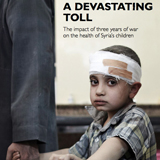
Syria’s three year civil war has had a devastating impact on children. At least 1.2 million children have fled the conflict, and become refugees in neighbouring countries, while another 4.3 million children in Syria are in need of humanitarian assistance.1 Children have witnessed and experienced extreme violence, and more than 10,000 young lives have been lost as a direct result.2
These horrifying facts are recognised worldwide. But this report for the first time tells another, less obvious, story of the forgotten casualties of war.
It is not just the bullets and the shells that are killing and maiming children. They are also dying from the lack of basic medical care. Syria’s health system has been devastated. As a result, increasing numbers of children are suffering and dying from diseases that would previously either have been treated or prevented from taking hold in the first place.
This is more than a crisis. It is the threatened collapse of an entire health system, which endangers the lives and well-being of millions of children.
Until the conflict started, Syria was a middle-income country, with child survival statistics to match. In 2012, the child mortality rate was 15 per 1,000 births, down from 38 in 1990, and Syria was broadly on track to reach Millennium Development Goal 4 – to reduce the child mortality rate from preventable diseases by two-thirds.3 These gains had been achieved because the country had a functioning health system that provided reasonably consistent standards of care, including high vaccination coverage rates for children, and universal coverage of skilled birth attendance and institutional delivery. 4
Three years on from the start of the conflict, the story could not be more different: a shattered health system resulting in brutal medical practices that have left millions of children suffering.
This report looks at the devastation of the health system in Syria and what this means for children and their mothers. It outlines the lack of skilled medical staff and access to child-focused care, equipment and medicine; the impact of the breakdown in the healthcare system on maternal and newborn health; and the rise of vaccine-preventable and infectious diseases in children. In short, Syria’s humanitarian crisis has become a devastating health crisis. Across Syria, 60% of hospitals5 and 38% of primary health facilities6 have been damaged or destroyed, and production of drugs has fallen by 70%.7 Nearly half of Syria’s doctors have fled the country: in Aleppo, a city which should have 2,500 doctors, only 36 remain.8
This report brings to light the lack of skilled medical staff and access to child-focused care, equipment and medicine; the impact of the breakdown in the healthcare system on maternal and newborn health; and the rise of vaccine-preventable and infectious diseases in children. The report concludes that much of the previous progress made in child health and child survival has been reversed and that immediate and unfettered humanitarian access, particularly for essential healthcare, is needed in order to halt the suffering and death of Syria’s children.
Our findings are based on primary and secondary health data from inside Syria, and Save the Children’s experience in responding to the crisis. Our research also involved conducting interviews with children and their parents.